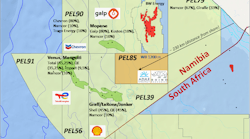Vello A. Kuuskraa, Tom E. Hoak, Jason A. Kuuskraa
Advanced Resources International Inc.
Arlington, Va.
John Hansen
Gas Research Institute
Chicago
The recognition 20 years ago that large scale hydraulic fracturing could unlock natural gas held in low permeability (tight) rocks launched the U.S. tight gas sands play. This play, born in the Appalachian and San Juan basins, expanded next into the major Rocky Mountain gas basins and more recently Texas and the Midcontinent, (Fig. 1 [33731 bytes]).
Today, tight gas is a significant and growing part of U.S. natural gas production involving a host of major E&P companies, such as Amoco, Chevron, and Texaco and particularly gas oriented, aggressive independents such as Union Pacific Resources, Enron Oil & Gas, Mitchell, Snyder, Barrett Resources, and Belden & Blake, among many others.
Except for regulatory purposes, the distinction between tight and conventional gas has increasingly blurred, replaced by more meaningful issues of reservoir properties, reserves per well, and the costs of hydraulic stimulation. If recent national resource assessments by the U.S. Geological Survey and National Petroleum Council hold, tight gas will be an increasingly essential part of tomorrow's gas supply.
Case studies and basin reviews presented in this article underscore the critical role that new E&P technology has played on tight gas resources-transforming subeconomic prospects into "hot" plays.
This report, the last of a four part series assessing unconventional gas development in the U.S., examines the state of the tight gas sands industry following the 1992 expiration of the qualification period for the Sec. 29 Nonconventional Fuels Tax Credit. Because tight gas sands were the most mature of the unconventional gas sources and received only a modest tax credit, one would not expect much change when the tax credit qualification period ended, and post-1992 drilling and production data confirm this.
What the overall statistics do not show, and thus the main substance of this article, is how rediscovered tight gas plays and the evolution in tight gas exploration and extraction technology have shifted the outlook for tight gas drilling and its economics from a low productivity, marginally economic resource to a low cost source of gas supply.
Development status
Tight gas sands have long been a mainstay of U.S. gas production. In 1975, tight sands already provided 1 tcf of annual production, primarily from the Appalachian and San Juan basins. Since then, tight gas sands development has expanded to a dozen significant gas basins, providing 2.5 tcf/year of gas supply.
Tight gas drilling peaked in the early 1980s and then plummeted along with overall oil and gas development when prices collapsed in the mid-1980s, but expanding gas markets and the Sec. 29 tax credit revived tight gas activity in the late 1980s. Improved technology and a closer understanding of the tight gas reservoirs maintained this gas play after tax credit qualification ended in 1992.
The key measures that define the current state of tight gas development are provided in Tables 1 [10721 bytes],2 10659 bytes] ,3 [11922 bytes] and 4 [11628 bytes] and summarized below. Data are provided, for the first time, for all significant tight gas basins, including the Appalachian basin.
The key measures show that tight gas is a healthy gas resource with new gas discoveries replacing mature and fully developed plays.
- Natural gas production from tight gas sands climbed to 2.49 tcf in 1994 from 2.35 tcf in 1992 (Table 1 [10721 bytes]). Increased production of tight gas in the Green River and Denver-Julesburg basins of the Rockies and the Lobo/ Wilcox trend of South Texas have accounted for much of the growth.
- Nearly 4,200 tight gas wells were drilled in 1993 and 1994, up 15% from 3,636 wells in 1992 (Table 2 [10659 bytes]). Increases in the Rockies and other basins countered de- clines in Appalachian tight gas drilling.
With favorable results being achieved in the Canyon sands of West Texas, the Lobo/Wilcox play of South Texas, and the lenticular Mesaverde sands of the Piceance basin, active development is expected for the next several years. A rebound from weak gas prices (particularly in the Rocky Mountain region) would further boost tight gas as well as total U.S. gas drilling.
- More than 122,000 tight gas sand wells are producing, more than one of three producing gas wells (Table 3 [11922 bytes]). Of these, 86,000 are low-productivity Appalachian basin wells targeting formations such as the Clinton/ Medina, Oriskany, and numerous Mississippian and Devonian age sands. The more productive San Juan basin is second with over 8,000 tight sands wells in the Mesaverde, Pictured Cliffs, and Dakota formations.
- Proved reserves of tight gas totaled 33 tcf at the end of 1994, up from 31 tcf in 1992, helping counterbalance the decline in U.S. conventional gas reserves (Table 4 [11628 bytes]). Strong reserve additions are noted in the Green River basin Frontier and Almond (Mesaverde) formations and Permian basin Canyon sands. Even the Appalachian basin shows a rebound in tight gas reserves as drillers pursue deeper, more productive horizons.
- Well productivity, measured in terms of new reserves per well, is up for tight gas in key basins after a long decline. Improved ability to locate wells in naturally fractured, highly productive areas, more aggressive multiple-zone completion of the full vertical stack of tight pay, and the use of less damaging frac fluids carrying higher proppant loads have helped improve reserves per well. Also contributing has been steady, but still limited, recompletion of older, inadequately stimulated tight gas wells in the Anadarko, Piceance, and Green River basins.
Rocky Mountain basins
With a massive resource, the Rockies are the "heart" of the tight gas sands play.
Much of the tight gas activity has been in the Green River basin, particularly on the Moxa arch in the west and the Wamsutter arch in the east. Also active has been the Denver basin with wells targeting the numerous sands in giant Wattenberg field. More recently, the Piceance basin has seen a revival of drilling in massively stacked lenticular Mesaverde sands.
San Juan basin
The San Juan basin holds the first tight, basin-centered gas plays to experience intense development.
After peaking in 1981, tight gas production, drilling, and reserves have steadily dropped. San Juan tight gas drilling was low during the final years of tax credit qualification and stayed low in 1993-94, but a new round of infill drilling may revive the play.
Mesaverde is the primary tight gas formation in this basin, followed by Dakota and Pictured Cliffs (Table 5 [12830 bytes]).
Green River basin
The Green River is the pre-eminent Rocky Mountain tight gas basin, accounting for two-thirds of the tight gas produced in this region.
Within the Green River basin, the two dominant tight gas formations are the Frontier and Mesaverde sands. (In addition, portions of the Dakota sandstone and Lewis shale were designated as tight gas by FERC). Tight gas production, drilling, and reserves have increased in this basin since qualifying ended for the Sec. 29 tax credits after 1992 (Table 6 [17392 bytes]).
Cretaceous Frontier is the dominant tight gas play in the Green River basin with 1,856 producing wells, 214 bcf/year of production, and 1.5 tcf of reserves remaining at yearend 1995. Much of the activity has been on the Moxa arch in fields such as Bruff, Fontenelle, and Whiskey Buttes led by Amoco, UPRC, Texaco, and Celsius.
The 188 gas wells completed in Frontier in 1995 constituted the first drop in drilling since 1990. While Frontier is deposited broadly on and downdip of the Moxa arch, drilling has focused on structure with enhancement of facies and natural fractures. At typical depths of 9,000-11,000 ft, wells cost $400,000-500,000 to drill and complete, with more costs for hydraulic stimulation and surface equipment. Strong initial gas rates and reserves per well enable this play to expand:
- An in-depth UPRC study of 165 Moxa arch Frontier wells showed average recovery of 2.3 bcf/well with initial rates of 1.5 MMcfd. UPRC is pursuing more effective cleanup and fracture optimization to further improve well rates and recoveries.
- Using a comprehensive data base of 1,800 Frontier wells, recent work by Barlow & Haun Inc. and ARI Inc. shows expected ultimate recoveries (EURs) of 2.1 bcf/well for Frontier. Up-to-date production data, inclusion of 1994-95 wells, and specifically constructed tight sand type curves were distinguishing features of this very recent well performance study.
Recent Frontier activities include infill drilling to downspace from 320 acres and selected exploration to extend the play downstructure and farther north and east of the Moxa arch. Notable is the joint GRI-DOE-UPRC 1 Stratos well being drilled to evaluate the formation properties and production potential of a 900 sq mile step-out area of deep, overpressured Frontier east of the Moxa arch. This 16,000 ft vertical well will add two 2,500 ft horizontal laterals at its base to characterize the formation and define the area's natural fracture setting.
The Almond formation of the Mesaverde Group comprises two distinct members: the Upper Almond marine sandstone; and the Lower Almond, Ericson lenticular sandstone. Highly productive wells are a hallmark of the tight gas play in Upper Almond, the main target of development to date, as exemplified by the 1 tcf of EUR from 196 wells drilled (through 1991) in Standard Draw (Coal Gulch-Echo Springs) field on the Wamsutter arch. Infill drilling to 320 acres/well is expected to add 0.3 tcf of reserves for this field area. Gas production, well completions, and producing wells have steadily increased in the Mesaverde Group since 1992 (Table 9 [12129 bytes]).
Piceance basin
Improved well siting and completion practices have revived a previously discovered but commercially condemned tight gas play in the southern Piceance basin of Colorado.
Here, the target is the massively stacked, lenticular sand of the Mesaverde (Williams Fork) formation stretching upward for several thousand feet from the top of the Rollins, through the Cameo coal and sand interval, to the gas and water transition zone below the Wasatch. Most of the activity has been at Rulison and Grand Valley/Parachute fields, where Barrett Re- sources is expanding, infilling, and recompleting wells, and further east at Mamm Creek, where Snyder has an active drilling program. Chevron, Occidental, and the DOE-Naval Oil Shale Reserve are other active participants in this area.
The Mesaverde tight gas play, discovered in 1959 by the Juhan 1 Fee, had strong early gas flow rates giving rise to high expectations. When subsequent wells showed low reserves (0.2-0.5 bcf/well), this play was relegated to a low productivity, high cost resource. Still, the National Petroleum Council and U.S. Geological Survey estimate that these tight sands hold 100-300 tcf in place.
Four events have combined to revive this play and make it economic at low prices:
1. Improved well siting and well completion practices have significantly raised the productivity and expected recovery for this gas play. Expected recovery from Williams Fork at Rulison field (Williams Fork) is up three fold from 0.56 bcf/well for pre-1985 wells to 1.88 bcf/well for wells drilled in 1994-95 (Fig. 2). Larger, more efficient stimulations, multiple-zone completions (four or more), and identification of higher productivity, naturally fractured trends have all contributed to this impressive improvement.
2.. Restimulation and uphole recompletions of previously completed wells are adding 1-2 bcf of EUR to older wells, as achieved by Barrett and DOE for selected Rulison wells.
3. The third impetus has been the start of intensive infill development, with wells now being placed on 40 acre spacing, down from 160 acres a few years ago. Recognition that the Mesaverde lenticular sands contain a massive, rich gas package of 100-120 bcf/sq mile and that current well spacing is recovering only a small fraction of gas in place provided the foundation for more intense development.
4. Most importantly, with better recoveries and lower well costs, the economics of this play have become favorable. Summary economics for the lenticular tight sands gas play shows expected RORs of 16-24% before tax (Table 7 [9412a403.gif]). Barrett, the main Rulison field operator, told the Colorado Oil & Gas Commission that a 1.8 bcf Rulison well at $700,000 provides it a 23% before tax ROR.
Denver basin
The Denver (or Denver-Julesburg) basin has long been a tight gas drilling "hot spot."
Within the basin, giant Wattenberg field has ranked first among U.S. fields the past 3 years in gas wells drilled. The main tight formations are the J (plus D) sand, Codell, and Sussex, with wells often completed jointly in several of these formations including the Niobrara, a gas shale. Niobrara, another active gas play in the Denver basin, was discussed in Part 3 of this series covering gas shales (OGJ, Jan. 22, p. 53).
A review of the status and development of Wattenberg tight gas field provides a quick, representative look at tight gas activity in this basin (Table 8 [13451 bytes]).
Uinta basin
Natural Buttes field, with 470 bcf produced to date from Wasatch, is the Uinta basin's dominant tight gas play.
Strong drilling in 1992 that added over 200 wells and continued albeit much slower activity in 1993-94 have raised tight gas production in this field from 24 bcf in 1991 to 59 bcf in 1994. Improved well completions and placement doubled productivity (Table 9 [12129 bytes]).
Wind River basin
Tight gas potential in the Wind River basin is largely undeveloped. Paleocene Fort Union, Lower Cretaceous Frontier, and Upper Cretaceous Mesaverde are the main tight gas formations.
After a flurry of activity in the early 1980s, drilling for these gas plays essentially stopped in 1985 and did not resume until 1994. A review of Muddy Ridge and Pavillion fields (Table 10 [15090 bytes]) provides a useful, representative review of the status of Wind River basin tight gas development.
- The initial 26 Muddy Ridge Fort Union tight gas wells had EUR of a little over 1 bcf/well, relegating this formation to a low productivity, marginally economic gas play. A more positive outlook emerged when drilling resumed in 1994 with five highly productive wells averaging 3.6 bcf/well. Field development expanded in early 1995 with eight new wells each averaging nearly 1 MMcfd.
- Four older wells in Muddy Ridge field have penetrated into the tight, thick Mesaverde section, with EURs of 2.4-6.1 bcf/well. The three wells still producing averaged 500 Mcfd each in 1994 and early 1995. No wells have been drilled into this formation since 1983.
- A somewhat different picture emerges for Pavillion Fort Union field, where the early wells averaged more than 4 bcf (with several 10 bcf wells). The early wells benefitted from the higher productivity but limited sand at the top of the formation. Wells drilled in 1993-94 into the main pay have averaged 2 bcf/well.
A new tight gas play is emerging in Cave Gulch field, along the highly fractured, overthrusted northeastern edge of the basin. Following the initial discovery in the shallower Fort Union and Lance formations, later wells have added the deeper Meeteetse and Mesaverde pays. Five wells completed to date by Barrett Resources are flowing a combined 54 MMcfd of gas plus condensate.
Appalachian basin
Most likely, the first tight gas well was drilled in the Appalachian basin, into one of the Mississippian or Devonian age sands in Pennsylvania. Today, tight gas is the main target in this basin, accounting for about three fourths of all gas well drilling in Ohio, Pennsylvania, and West Virginia. Devonian age gas shales and coalbed methane drilling account for the bulk of gas wells in the Appalachian basin states of Kentucky and Virginia, respectively.
Appalachian basin tight sands provide about 400 bcf/year of natural gas supply from 86,000 wells. Many of these wells are old and now only marginally economic, producing 10 Mcfd or less. About 8,000 of these low productivity wells have been shut-in since 1992.
Although new well completions are down 10%, tight gas production in this basin has remained relatively stable and may rise based on a rebound in the productivity of new wells and total reserves. The basin still offers potential to those who understand its complex geology, can take advantage of its proximity to high value Northeastern markets, and can manage the exploration risk.
Of the numerous tight gas formations in the Appalachian basin, two stand out-the widespread Clinton/Medina gas play of Ohio and western Pennsylvania, and the deep, high risk but often highly productive Oriskany gas play in southern Pennsylvania and eastern West Virginia. The exciting new Rose Run (Knox) play in Ohio and New York also has a significant portion of tight gas wells.
Clinton/Medina
The Clinton/Medina formation, the primary target for tight gas sand development in Ohio, has become mature and is experiencing a sharp drop in drilling (Table 11 [7843 bytes]).
More than 3,000 wells/ year were drilled into the Clinton in the early to mid 1980s, but drilling has dropped to only 269 wells in 1994.
In an attempt to boost reserves per well, Belden & Blake and DOE's Morgantown Energy Technology Center drilled an R&D horizontal well into the Clinton formation in August 1995, but results fell short of expectations. Belden & Blake continues its vertical Clinton development.
With recoverable reserves falling below 0.1 bcf/well, this gas play has become economically marginal even with low drilling/completion costs of $110,000.
In Pennsylvania, the Clinton equivalent is the Medina formation. Most Medina wells the last few years have been in the deeper part of the play in southwestern Pennsylvania, targeting local "sweet spots" where fault systems and fracture zones intersect to form productive zones. Drilling for Medina tight gas is expected to remain stable the next few years, local operators indicate.
Oriskany
With reports of good wells, the deep Lower Devonian Oriskany formation is experiencing a resurgence.
Operators hope to duplicate the success of Fox Oil & Gas Co. in Fayette and Preston counties, Pa. One of these Oriskany wells, drilled in 1994, had an IP of 50 MMcfd.
Few Oriskany wells are that successful, but some produce over 10 bcf. The average is 1-2 bcf. More widespread use of seismic and other methods for identifying the "sweet spots" and new well stimulation technology would help expand the Oriskany play.
Other targets
Increased activity in Ohio's Rose Run formation (Knox), currently the basin's most exciting new gas (plus oil) play has helped counter the drop in Clinton drilling. The statement in Belden & Blake's 1994 annual report illustrates the attraction of this play:
"The average Knox (Rose Run) well produces four times the reserves of the average Clinton well for twice the cost." As the success rates in this play have increased from about 33% in the late 1980s to about 67% currently, the economic attraction of the Rose Run has blossomed. Rose Run well drilling and success rates have increased (Table 12 [10475 bytes]). The Ohio Oil & Gas Division estimates that 10-20% of the Rose Run gas wells are tight.
The experience of Belden & Blake, one of the Appalachian basin's more active operators, provides a vivid snapshot of the changes under way in tight gas (and other gas formation) development in the Appalachian basin (Table 13 [12467 bytes]).
- Belden & Blake's Appalachian basin drilling program (with gas as the main target) has expanded greatly from 19 wells in 1991 and 1992 to 92 wells in 1994.
- Drilling for the deeper, less developed Rose Run (27 wells) and Oriskany (four wells) provided the larger share of new reserves additions in 1994. Within the shallow, blanket formations, only 11 wells targeted the Clinton/Medina, historically, the main horizon for Belden & Blake and other Ohio drillers.
Other tight gas basins
Val Verde basin
The Canyon (Permian Wolfcamp) sandstone is an active, prolific tight gas formation in the Val Verde basin. Two distinct stratigraphic intervals, the Sonora Canyon sands of Sutton County and the Ozona Canyon sands of Crockett County, form the heart of this gas play. As of 1992, 4,600 active completions had produced 2.3 tcf of gas from the two Canyon intervals.
New well drilling previously averaged 200 wells/ year and climbed to more than 400 in 1994. Gas flows (after stimulation) average an initial 2-3 MMcfd but decline rapidly in this naturally fractured tight formation.
Improved hydraulic fracturing, more efficient gas processing, and reduced well costs help explain the jump in activity and entry of majors such as Chevron, Conoco, and Phillips, and independents such as Enron and Meridian Oil into this play.
UPRC, a new operator in the Ozona Canyon sands having acquired 800 wells from Amax Oil & Gas in 1994, participated in 144 gross (97 net) new wells in 1994 and is building two fully automated, 100 MMcfd cryogenic gas processing plants to recover NGLs.
A second highlight has been the use of more cost-effective drilling and completion practices that have reduced costs for these 7,000 ft single completion wells from $320,000 to $225,000, with a goal of $200,000.
Anadarko basin
The Cherokee Group tight gas formation, a lower Desmoinesian (Pennsylvanian age) fluvial-deltaic sandstone, is the main tight gas play in the Anadarko basin.
This group includes the Cherokee, Red Fork, Skinner, Prue, Deese, and Desmoinesian sands. Within the larger Cherokee Group play that covers much of Northwest Oklahoma is an 858,880-acre area, centered in Roger Mills and Custer counties, that has been legally designated as tight gas by FERC.
Producing gas wells in the deep (12,000-13,000 ft) Cherokee tight sand have climbed steadily since 1990. Gas production tracked the well count through 1994 but began to decline in 1995 (Table 14 [14418 bytes]). Improvements in perforating and hydraulic fracturing have increased the peak gas production rate from 800 Mcfd in the mid-1980s to 1.2 MMcfd in the early 1990s. A reduction in well drilling costs, from $120/ft in the mid-1980s to $80/ft recently, has helped maintain this gas play since tax credit qualification ended. With the older wells drilled on 640 acres, the area offers considerable potential for further infill drilling, recompletions, and step-out development.
The Pennsylvanian age Cleveland formation, located west of the Cherokee gas play in the Texas Panhandle, has produced about 700 bcf of tight gas from about 1,000 wells. The depth to Cleveland ranges from 6,000 ft in the western edge of the play in Hansford County to 8,000 ft along the eastern edge in Lipscomb County.
The major field in this play, Ellis Ranch (Cleveland) in Ochiltree County with 221 wells, has produced 220 bcf as of mid-1995. Drilling in this gas play has remained relatively stable, leading to a steady climb in producing wells (Table 14 [14418 bytes]).
Tight gas production of 70 MMcfd in 1992 climbed to 80 MMcfd in 1994 and declined somewhat in 1995. However, operator enthusiasm for this large tight gas play, estimated by the NPC to hold 4-6 tcf of recoverable gas, appears to be on the upswing.
Others
Other important tight gas basins and formations continue to be actively pursued, with the efficiencies of new technology substituting for the past price boost from the tax credit.
While these basins and formations have been well covered in other technical articles and reports, a few highlights will help round out the picture of the current status of tight gas sands development:
- The Lower Wilcox Lobo tight gas trend along the Texas Gulf Coast has produced more than 4 tcf since discovery in 1973. The latest data (1994) show that about 2,000 wells produce 400 bcf/year in this tight gas play, with both completions and production up by 10% from 1992.
A typical Lobo well recovers 2.5-3.0 bcf, with a small group of wells reaching 10 bcf or more. Well costs that exceeded $1 million have been reduced to $750,000 for a 10,000 ft well, says Sonat Exploration.
Mobil, an active developer, reported that wells based on 3D seismic recorded an 84% success rate versus 70% using 2D seismic. TransTexas, the play's most active independent, also credits seismic and improved fracturing fluids for improvements in its wells.
- The Cotton Valley (and Travis Peak) formations in East Texas hold 4,000 tight gas wells producing 500 bcf/year. Extensive R&D on hydraulic fracturing, by GRI and a variety of industry partners, has helped unlock this gas play.
- Numerous other significant tight gas formations, such as Vicksburg, Olmos, and Edwards lime in the Texas Gulf Coast, Abo, Strawn, and Morrow in the Permian Basin, and Atoka in the Arkoma basin round out the tight gas play.
Next week: How advances in four key technologies have bolstered tight sands gas development.
Acknowledgment
The authors thank the numerous state oil and gas boards that contributed valuable information, especially Ronald Riley, Ohio Division of Oil & Gas; Lee Avary, West Virginia Geological Survey; and Pam Hudson, Oklahoma Corporation Commission, as well as Mark Doelger at Barlow & Haun and Gary Cartwright at Enron Oil & Gas.
The Authors
Vello Kuuskraa is president and cofounder of Advanced Resources International. He has more than 20 years' experience in energy resources development, technology, and economics. Before founding ARI, he was chairman of ICF Resources and cofounder of Lewin & Associates Inc. He received an MBA from the Wharton Graduate School of the University of Pennsylvania and a BS in mathematics/economics from North Carolina State University.
Jason Kuuskraa is a research assistant at Advanced Resources. He specializes in the analysis of U.S. unconventional gas resources, especially in the Appalachian basin. He formerly worked as an energy analyst for Cambridge Energy Research Associates. He has degrees in mathematics and history from Boston College.
Thomas E. Hoak is a structural geologist with Advanced Resources International Inc. in Denver. His professional experience includes research on the structural geology of the Taconic allochthon in west-central Vermont, fractured tight gas reservoirs in the Travis Peak formation, East Texas, reservoir characterization of complex stratigraphic oil traps of the Delaware basin, the structural geology; tectonics, and geochemical evolution of Northwest Italy's La Spezia region, and detailed studies of fractured reservoirs in the San Juan and Piceance basins. He has degrees from Carleton College, State University of New York, and the University of Texas-Austin.
John T. Hansen is a senior product manager for supply products at Gas Research Institute. He leads the Emerging Resources Team, which develops technology for the identification, evaluation, and exploitation of gas resources in the lower 48 U.S. Targeted resources include tight sands, coalbed methane, shales, and conventional gas. Before joining GRI, he was a reservoir engineer at Shell Western E&P. He has a BS in geological engineering from Colorado School of Mines and an MBA from the University of St. Thomas, Houston.
Copyright 1996 Oil & Gas Journal. All Rights Reserved.






